Running of the Bulls
| Running of the Bulls (encierro) | |
|---|---|
 The bull run in Pamplona | |
| Dates | 6-14 July |
| Location(s) | Pamplona and other |
The Running of the Bulls (in Spanish: encierro, from the verb encerrar, "to corral, to enclose") is a practice that involves running in front of a small group of cattle, typically six, of the toro bravo breed that have been let loose on a course of a sectioned-off subset of a town's streets.[1]
The most famous running of the bulls is the eight-day festival of Sanfermines in honour of Saint Fermin in Pamplona,[2] although they are also traditionally held in other places such as towns and villages across Spain, Portugal, in some cities in Mexico,[3] and southern France during the summer.
The origin of this event comes from the need to transport the bulls from the fields outside the city, where they were bred, to the bullring, where they would be killed in the evening.[4] During this 'run', youngsters would jump among them to show off their bravado. In Pamplona and other places, the six bulls in the event are still those that will feature in the afternoon bullfight of the same day.
Spanish tradition says the true origin of the run began in northeastern Spain during the early 14th century. While transporting cattle in order to sell them at the market, men would try to speed the process by hurrying their cattle using tactics of fear and excitement. After years of this practice, the transportation and hurrying began to turn into a competition, as young adults would attempt to race in front of the bulls and make it safely to their pens without being overtaken. When the popularity of this practice increased and was noticed more and more by the expanding population of Spanish cities, a tradition was created and stands to this day.[5]
Pamplona bull run
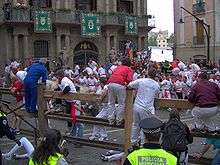
The Pamplona[2] encierro is the most popular in Spain and has been broadcast live by RTVE, the public Spanish national television channel, for over 30 years.[6] It is the highest profile event of the San Fermin festival, which is held every year from July 6–14.[2] The first bull running is on July 7, followed by one on each of the following mornings of the festival, beginning every day at 8 am. Among the rules to take part in the event are that participants must be at least 18 years old, run in the same direction as the bulls, not incite the bulls, and not be under the influence of alcohol.[7][8]
Fence
In Pamplona a set of wooden fences is erected to direct the bulls along the route and to block off side streets. A double wooden fence is used in those houses where there is enough space for it, while in other parts the buildings of the street act as barriers. The gaps in the barricades are wide enough for a human to slip through, but narrow enough to block a bull. The fence is composed of around three thousand separate pieces and while some parts are left for the duration of the fiesta others are mounted and dismounted every morning.[9] Spectators can only stand behind the second fence, whereas the space between the two fences is reserved for security and medical personnel and also to participants who need cover during the event.[8]
Preliminaries
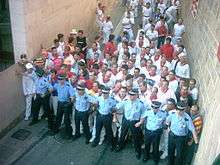
The encierro begins with runners singing a benediction. It is sung three times, each time being sung both in Spanish and Basque. The benediction is a prayer given at a statue of Saint Fermin, patron of the festival and the city, to ask the saint's protection and can be translated into English as "We ask Saint Fermin, as our Patron, to guide us through the encierro and give us his blessing". The singers finish by shouting "Viva San Fermín!, Gora San Fermin!" ("Long live Saint Fermin", in Spanish and Basque).[7] Most runners dress in the traditional clothing of the festival which consists of a white shirt and trousers with a red waistband ("faja") and neckerchief ("pañuelo"). Also some of them hold the day's newspaper rolled to draw the bulls' attention from them if necessary.[7]
The running
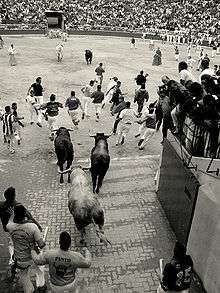
A first rocket is set off at 8 a.m. to alert the runners that the corral gate is open. A second rocket signals that all six bulls have been released. The third and fourth rockets are signals that all of the herd has entered the bullring and its corral respectively, marking the end of the event.[7] The average duration between the first rocket and the end of the encierro is two minutes, 30 seconds.[7]
The encierro is usually composed of the six bulls to be fought in the afternoon, six steers that run in herd with the bulls, and three more steers that follow the herd to encourage any reluctant bulls to continue along the route. The function of the steers, who run the route daily, is to guide the bulls to the bullring.[7] The average speed of the herd is 24 km/h (15 mph).[7]
The length of the run is 875 meters (957 yards). It goes through four streets of the old part of the city (Santo Domingo, Ayuntamiento, Mercaderes and Estafeta) via the Town Hall Square and the short section "Telefónica" (so named for the mobile phone operator located at the intersection) just before entering into the bullring through its callejón (tunnel).[2] The fastest part of the route is up Santo Domingo and across the Town Hall Square, but the bulls often became separated at the entrance to Estafeta Street as they slowed down. One or more would slip going into the turn at Estafeta ("la curva"), resulting in the installation of anti-slip surfacing, and now most of the bulls negotiate the turn onto Estafeta and are often ahead of the steers. This has resulted in a quicker run. Runners are not permitted in the first 50 meters of the encierro, which is an uphill grade where the bulls are much faster.
Injuries, fatalities and sanitary attention
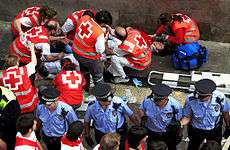
Every year, between 50 and 100 people are injured during the run.[7] Not all of the injuries require taking the patients to the hospital: in 2013 50 people were taken by ambulance to Pamplona's hospital, with this number nearly doubling that of 2012.[10]
Goring is much less common but potentially life threatening. In 2013 for example, 6 participants were gored along the festival, in 2012 only 4 runners were injured by the horns of the bulls with exactly the same number of gored people in 2011, 9 in 2010 and 10 in 2009; with one of the latter killed.[10][11] As most of the runners are male, only 5 women have been gored since 1974. Previously to that date running was prohibited for women.[12]
Another major risk is runners falling and piling up (a "montón") at the entrance of the bullring , which acts as a funnel as it is much narrower than the previous street. In such cases injuries come both from asphyxia and contusions to those in the pile and from goring if the bulls crush into the pile. This kind of blocking of the entrance has occurred at least ten times in the history of the run, the last occurring in 2013 and the first dating back to 1878. A runner died of suffocation in one such pile up in 1977.[13]
Overall, since record-keeping began in 1910, 15 people have been killed in the bull running of Pamplona, most of them due to being gored.[7] To minimize the impact of injuries every day 200 people collaborate in the medical attention. They are deployed in 16 sanitary posts (every 50 metres on average), each one with at least a physician and a nurse among their personnel. Most of these 200 people are volunteers, mainly from the Red Cross. In addition to the medical posts, there are around 20 ambulances. This organization makes it possible to have a gored person stabilized and taken to a hospital in less than 10 minutes.[14]
| Year | Name | Age | Origin | Location | Cause of death |
|---|---|---|---|---|---|
| 1924 | Esteban Domeño | 22 | Navarre, Spain | Telefónica | Goring[15] |
| 1927 | Santiago Zufía | 34 | Navarre, Spain | Bullring | Goring[15] |
| 1935 | Gonzalo Bustinduy | 29 | San Luis Potosí, Mexico | Bullring | Goring[15] |
| 1947 | Casimiro Heredia | 37 | Navarre, Spain | Estafeta | Goring[15] |
| 1947 | Julián Zabalza | 23 | Navarre, Spain | Bullring | Goring[15] |
| 1961 | Vicente Urrizola | 32 | Navarre, Spain | Santo Domingo | Goring[15] |
| 1969 | Hilario Pardo | 45 | Navarre, Spain | Santo Domingo | Goring[15] |
| 1974 | Juan Ignacio Eraso | 18 | Navarre, Spain | Telefónica | Goring[15] |
| 1975 | Gregorio Gorriz | 41 | Navarre, Spain | Bullring | Goring[15] |
| 1977 | José Joaquín Esparza | 17 | Navarre, Spain | Bullring | Suffocated in a pile-up.[7] |
| 1980 | José Antonio Sánchez | 26 | Navarre, Spain | Town Hall Square | Goring[15] |
| 1980 | Vicente Risco | 29 | Badajoz, Spain | Bullring | Goring[15] |
| 1995 | Matthew Peter Tassio | 22 | Glen Ellyn, Illinois, USA | Town Hall Square | Goring[16] |
| 2003 | Fermín Etxeberria | 63 | Navarre, Spain | Mercaderes | Hit by a horn[17] |
| 2009 | Daniel Jimeno Romero | 27 | Alcalá de Henares, Spain | Telefónica | Goring[18][19] |
Dress Code
Though there is no formal dress code, the very common and traditional attire is white pants, white shirt with a red scarf around the waist and a red handkerchief around the neck. The majority of runners are similarly dressed, many times with red wine stains from the previous night or earlier in the festival.
Another common dress practice, seen as a risk by some but as a daring depiction of courage by others is dressing in a conspicuous manner. Many runners that want to be perceived as daring wear colors other than white, a common alternate color choice is blue. Blue is thought by some to draw the bulls' attention. Others include large logos on their shirt to capture the attention of the bulls. In the age of social media explosion, this also thought to be a way to highlight someone in a photo.[20]

Media
The encierro of Pamplona has been depicted many times in literature, television or advertising, but became known worldwide partly because of the descriptions of Ernest Hemingway in books The Sun Also Rises and Death in the Afternoon. The cinema pioneer Louis Lumière filmed the run in 1899.[21]
The event is the basis for a chapter in James Michener's 1971 novel The Drifters.
The run is depicted in the 1991 Billy Crystal film City Slickers where the character "Mitch" (Crystal) is gored (non-fatally) from behind by a bull during a vacation with the other main characters.
The run appears in the 2011 Bollywood movie Zindagi Na Milegi Dobara, directed by Zoya Akhtar, as the final dare in the bucket list of the three bachelors who have to overcome their ultimate fear; death. At first, the trio run part of the route. They stop at the square, but then recover their nerve, and continue to the end. The completion of the run depicts their freedom as they learn that surviving a mortal danger can bring joy.
Running with the Bulls, a 2012 documentary of the festival filmed by Construct Creatives and presented by Jason Farrel, depicts the pros and cons of the controversial tradition.[22]
Since 2014 the Esquire Channel has broadcast the running of the bulls as a show in the US,[23] with both live commentary and then a recorded 'round up' later in the day by NBCSN commentators the Men in Blazers, including interviews with noted participants such as Madrid-born runner David Ubeda,[24] former US Special Forces soldier turned filmmaker Dennis Clancey,[25] the historic New York-born runner Joe Distler[26] and former British bullfighter and author Alexander Fiske-Harrison.[27]
In 2014, the eBook guide Fiesta: How To Survive The Bulls Of Pamplona caused headlines around the world when one of the contributors was gored by a bull soon after its publication.[28] (See Further Reading section below.)
Other examples
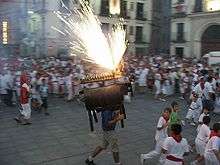
Although the most famous running of the bulls is that of San Fermín,[2] they are held in towns and villages across Spain, Portugal, and in some cities in southern France during the summer. Examples are the bull run of San Sebastián de los Reyes, near Madrid, at the end of August which is the most popular of Spain after Pamplona, the bull run of Cuéllar, considered as the oldest of Spain since there are documents of its existence dating back to 1215, the Highland Capeias of the Raia in Sabugal, Portugal, with horses leading the herd crossing old border passes out of Spain and using the medieval 'Forcåo', or the bull run of Navalcarnero held at night.
Other encierros have also caused fatalities.[29]
Stamford Bull Run
The English town of Stamford, Lincolnshire was host to the Stamford Bull Run for almost 700 years until it was abandoned in 1837.[30] According to local tradition, the custom dated from the time of King John when William de Warenne, 5th Earl of Surrey, saw two bulls fighting in the meadow beneath. Some butchers came to part the combatants and one of the bulls ran into the town, causing a great uproar. The earl, mounting his horse, rode after the animal, and enjoyed the sport so much, that he gave the meadow in which the fight began, to the butchers of Stamford, on condition that they should provide a bull, to be run in the town every 13 November, for ever after. As of 2013 the bull run had been revived as a ceremonial, festival-style community event.
Mock bull runs
A variation is the nightly "fire bull" where balls of flammable material are placed on the horns. Currently the bull is often replaced by a runner carrying a frame on which fireworks are placed and dodgers, usually children, run to avoid the sparks.
In 2008 Red Bull Racing driver David Coulthard and Scuderia Toro Rosso driver Sébastien Bourdais performed a version of a 'bull running' event in Pamplona, Spain, with the Formula One cars chasing 500 runners through the actual Pamplona route.[31]
The Big Easy Rollergirls roller derby team has performed a version of annual bull run in New Orleans, Louisiana since 2007. The team, dressed as bulls, skates after runners through the French Quarter. In 2012 there were 14,000 runners and over 400 "bulls" from all over the country, with huge before- and after-parties.[32][33][34]
In Ballyjamesduff, Ireland, an annual "Pig Run" is held. It looks just like encierro but with wild boars instead of bulls.
In Dewey Beach, Delaware, the Starboard bar[35] sponsors an annual Running of the Bull [sic], in which hundreds of red and white-clad beachgoers are chased down the shore by a single "bull" (two people in a costume).
In Rangiora, New Zealand, an annual "Running of the Sheep" is held. Where 1000-2000 sheep are released down the main street of the small farming town.
The Running of the Bulls UK is a pub crawl event that takes place on London's Hampstead Heath and uses fast runners in place of bulls.
Opposition
Many animal rights activists oppose the event. PETA activists created the "running of the nudes", a demonstration done two days before the beginning of San Fermín in Pamplona. By marching naked, they protested the festival and the following bullfight, arguing the bulls are tortured for entertainment.[36]
The city of San Miguel de Allende, Mexico, cancelled its Sanmiguelada running of the bulls after 2006, citing public disorder associated with the event.[37] After the event was cancelled in San Miguel, the city of Salvatierra, also in the state of Guanajuato, picked up the event. It is now called La Marquesada and the three-day event is held during the last weekend of the month of September or first weekend of October.
Further reading
Fiske-Harrison, Alexander (Editor). Fiesta: How To Survive The Bulls Of Pamplona, 2014, Mephisto Press. Edited by the British author who trained as a bullfighter, with a foreword by the Mayor of Pamplona, and contributions by the most experienced Spanish and American bull-runners such as Julen Madina and Joe Distler, as well as from famous aficionados of Pamplona such as John Hemingway, grandson of Ernest Hemingway and Beatrice Welles, daughter of Orson Welles.
See also
References
- ↑ Fiske-Harrison, Alexander (Editor) Fiesta: How To Survive The Bulls Of Pamplona, Mephisto Press, 2014
- 1 2 3 4 5 "Sanfermin guide. Running of the bulls". Kukuxumusu. 2007. Retrieved 2008-07-21.
- ↑ "Bull-run hits liquor-fueled town", February 2, 2009. "The tradition, enacted in a handful of Mexican towns, traces its roots back to the centuries-old Pamplona bull-run in Mexico's former colonial power." Retrieved March 4, 2009.
- ↑ According to the Mayor of Pamplona in his foreword to the book Fiesta: How To Survive The Bulls Of Pamplona
- ↑ Running of the Bulls 2011 Live Stream (Event Information)
- ↑ "27 añllj ghjzest in a penises en TVE". RTVE. 2008. Retrieved 2008-07-21.
- 1 2 3 4 5 6 7 8 9 10 11 "The Bull Run". Ayuntamiento de Pamplona (Council of Pamplona). Retrieved 2008-07-21.
- 1 2 "Sección quinta". Bando San Fermin 2014. Ayuntamiento de Pamplona. Retrieved 20 March 2015.
- ↑ "Encierro bullrun San Fermin festival Sanfermines tourist information on Navarre". Government of Navarre. Retrieved 2010-03-08.
- 1 2 Gorka Alonso (15 July 2013). "Los encierros se saldan con 50 heridos trasladados y 6 corneados" (in Spanish). Noticias de Navarra. Retrieved 15 July 2013.
- ↑ "Los encierros de 2012 dejan cuatro heridos por asta, los mismos que en 2011" (in Spanish). Diario de Noticias. 14 July 2012. Retrieved 13 July 2013.
- ↑ E.F.E Pamplona (14 July 2013). "Quinta mujer corneada en los encierros de San Fermín" (in Spanish). Diario de Navarra. Retrieved 15 July 2013.
- ↑ Javier Doria (13 July 2013). "Montón en el encierro de Sanfermines, un peligro con historia" (in Spanish). El País. Retrieved 14 July 2013.
- ↑ "Especialistas destacan que el dispositivo sanitario de los encierros "no se puede mejorar" porque es "espectacular"" (in Spanish). Diario de Navarra. 18 June 2009. Retrieved 16 July 2013.
- 1 2 3 4 5 6 7 8 9 10 11 Terra Noticias. "La muerte de hoy es la número quince en la historia del encierro" (in Spanish). Noticias.terra.es. Retrieved 2012-07-06.
- ↑ "The last person killed at Pamplona". BBC. 14 July 2005. Retrieved 10 July 2009.
...Matthew Tassio...22 years old and came from Chicago...The...bull...hit him in the abdomen, severed a main artery, sliced through his kidney and punctured his liver
- ↑ "Muere el pamplonés Fermín Etxeberria, de 63 años, herido en el encierro del 8 de julio" (in Spanish). DiarioDeNavarra.es. 25 September 2003. Retrieved 10 July 2009.
- ↑ "Bull gores man to death in Spain". BBC. 10 July 2009. Retrieved 10 July 2009.
The 27-year-old was gored in the neck on Friday, during the fourth bull run of the week-long San Fermin festival. Daniel Jimeno Romero, from Madrid, had emergency surgery in hospital but died of his injuries. Earlier reports had described the dead man as British....a veteran Spanish bull-runner died after a fall in 2003
- ↑ "One dead in the running of the bull’s in Pamplona". EncierroSanFermin.com. 10 July 2009. Retrieved 10 July 2009.
A runner died in today’s running of the bulls in the northern spanish city of Pamplona, the bull running held during the famous San Fermin festivities. The man died after being gored in the neck and lung by a bull of the Jandilla ranch, named "Capuchino".The runner, Daniel Jimeno Romero from Alcalá de Henares (Madrid) was at the end of the street run
- ↑ http://gospain.about.com/od/spanishfestivals/qt/pamplonasurvive.htm
- ↑ Encierro de toros in the Spanish-language Auñamendi Encyclopedia.
- ↑ (http://www.imdb.com/title/tt2328852/)
- ↑ 'Running Of The Bulls', Esquire TV
- ↑ Vadillo, Jose Luis. 'Así son los corredores de elite en San Fermín', El Mundo. 6 July 2015
- ↑ Editorial Staff. 'Pamplona, bull running, bull gorings, Esquire TV and poetry from New York', The Pamplona Post. 10 July 2015
- ↑ Joe Distler website
- ↑ 'Running Of The Bulls 2015: A Democratic Sport, Esquire TV
- ↑ 'San Fermín So Far - 2014' The Pamplona Post, 12 July 2014
- ↑ Mari Carmen López del Burgo, aged 48, from Madrid, Spain. "Muere una mujer embestida por un toro en los encierros de Arganda del Rey" (in Spanish). elpais.com. 9 September 2010. Retrieved 9 September 2010.
- ↑ Chambers Book of Days (1864),. W. & R. Chambers ltd. 1832. 13 November entry
- ↑ "Red Bull to visit Pamplona for Bull running". GPUpdate.net (GPUpdate). 11 June 2008. Retrieved 30 January 2011.
- ↑ Keith I. Marszalek, NOLA.com (2007-06-24). "Big Easy Rollergirls to reinact [sic] famed bull run". Blog.nola.com. Retrieved 2011-07-02.
- ↑ "San Fermín in Nueva Orleans, The Running of the Roller Girls". Laughingsquid.com. 2008-07-20. Retrieved 2011-07-02.
- ↑ Coviello, Will. "Running of the Bulls 2012". Gambit Weekly. Retrieved 18 July 2012.
- ↑ "Dewey Beach, DE". The Starboard. Retrieved 2011-07-02.
- ↑ Running of the Nudes. PETA official site.
- ↑ "No More Bull (Running, That Is) in San Miguel de Allende," Austin American-Statesman, May 24, 2007. Retrieved March 4, 2009
External links
| Wikimedia Commons has media related to Running of the Bulls. |
- http://thebullsofpamplona.com The website of the eBook 'Fiesta: How To Survive The Bulls Of Pamplona'
- http://thepamplonapost.com A blog about Pamplona's annual bull-running festival
- http://www.pamplonabullruntickets.com/pamplona-bull-run-2015/ How to attend in safety
- http://stoketravel.com/the-running-of-the-bulls/ Student Travel and Party at Running of the Bulls
- Google Maps Route Map
| ||||||||||||||||||||||||||||||||||||||||||||||||||||||||||||||||||||